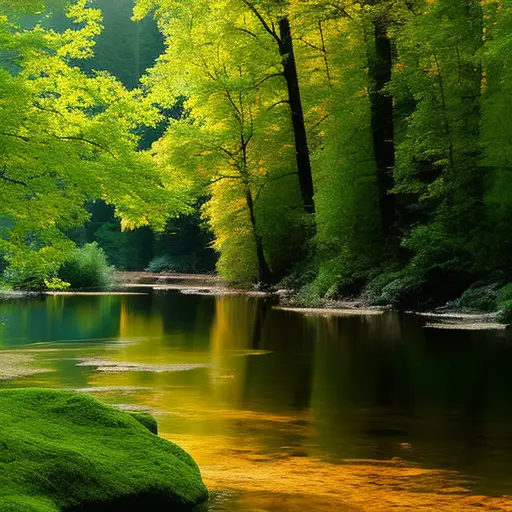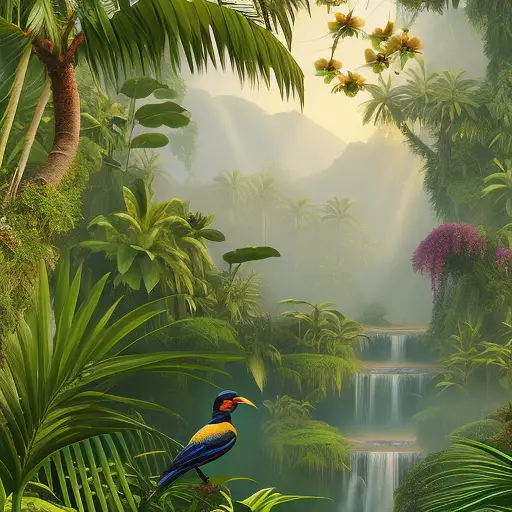The Importance of Preserving Wild Water Sources

Imagine a world without the serene rush of a mountain stream or the tranquil beauty of a pristine lake. As we embark on an era of rapid urbanization, it is crucial to recognize the importance of preserving our wild water sources.
These natural wonders not only provide habitat for countless species, but also serve as lifelines for human communities. In this article, we will explore the threats faced by these invaluable resources, the consequences of their loss, and the strategies and global initiatives in place to ensure their preservation.
Threats to Wild Water Sources
One of the most pressing issues regarding wild water sources is the multitude of threats they face due to human activities. These threats include pollution and water scarcity, both of which have significant implications for the health and sustainability of wild water sources.
Pollution control is crucial in preserving the quality of wild water sources. As human activities continue to release pollutants into the environment, wild water sources become vulnerable to contamination. Industrial waste, agricultural runoff, and improper waste disposal all contribute to the pollution of these water sources. To mitigate this threat, strict regulations and effective pollution control measures must be implemented to ensure the preservation of water quality.
In addition to pollution, water scarcity poses a significant threat to wild water sources. As global populations and demands for water increase, the availability of freshwater in these sources becomes limited. Climate change exacerbates this issue, as it alters precipitation patterns and leads to more frequent droughts. Sustainable water management practices, such as the implementation of efficient irrigation systems and the conservation of water resources, are necessary to address water scarcity and protect wild water sources.
Importance of Ecosystem Preservation
Preserving wild water sources is crucial because it ensures the conservation of ecosystems that rely on these habitats for their survival. Ecosystem preservation is of utmost importance in the face of climate change and biodiversity loss, as these factors pose significant threats to the delicate balance of natural systems.
-
Climate change: Preserving wild water sources helps to mitigate the impacts of climate change. Bodies of water, such as rivers and wetlands, act as natural carbon sinks, absorbing and storing carbon dioxide. Additionally, these habitats provide important cooling effects, regulating local temperatures and reducing the heat island effect in urban areas.
-
Biodiversity loss: Wild water sources are home to a wide variety of species, many of which are highly dependent on these habitats for their survival. By preserving these ecosystems, we protect the biodiversity they support, ensuring the survival of numerous plant and animal species. This is particularly important in the face of increasing biodiversity loss, which has far-reaching ecological consequences.
-
Ecosystem services: Wild water sources provide a range of valuable ecosystem services, such as water filtration, flood control, and nutrient cycling. Preserving these ecosystems ensures the continuity of these services, benefiting both human populations and the surrounding environment.
Human Dependence on Wild Water Sources
Human dependence on wild water sources is a critical aspect of sustainable water management and the health and stability of ecosystems. These sources provide humans with essential freshwater for drinking, agriculture, and industrial purposes.
Moreover, preserving the quality and quantity of wild water sources ensures the availability of clean water for future generations and helps maintain the balance of natural ecosystems.
Sustainable Water Management
Effective management of wild water sources is crucial for ensuring the long-term sustainability of human water consumption. As the world faces increasing challenges of water scarcity and water pollution, it is essential to implement sustainable water management practices. Here are three key aspects of sustainable water management:
-
Conservation: Implementing measures to conserve water resources and reduce wastage is vital. This can include promoting water-saving technologies, implementing water-efficient irrigation systems, and raising awareness about the importance of water conservation.
-
Pollution control: Preventing and reducing water pollution is essential to maintain the quality of wild water sources. Implementing strict regulations on industrial discharges, improving wastewater treatment processes, and promoting eco-friendly farming practices are crucial steps in pollution control.
-
Integrated approach: Adopting an integrated approach to water management involves considering the entire water cycle and its interconnectedness with other sectors such as agriculture, industry, and urban development. This approach ensures the sustainable use of water resources while minimizing conflicts and maximizing benefits.
Ecosystem Health and Stability
Maintaining the health and stability of ecosystems is crucial for the sustainable utilization of wild water sources. Ecosystems play a vital role in water conservation and ensuring the availability of clean and safe drinking water for human populations. By safeguarding natural habitats and preserving biodiversity, we can help protect and preserve water sources. Ecosystem conservation contributes to the regulation of water cycles, filtration of pollutants, and the prevention of erosion. To understand the significance of ecosystem health, consider the following table:
| Ecosystem Health | Benefits |
|---|---|
| Biodiversity | Ensures resilience and adaptability of ecosystems |
| Wetlands | Filter and purify water |
| Forests | Prevent soil erosion and regulate water flow |
| Aquatic ecosystems | Provide habitat for aquatic species |
Impacts of Urbanization on Water Sources
Urbanization has significant impacts on water sources, particularly in relation to deforestation and water quality.
As urban areas expand, forests are often cleared to make way for infrastructure, leading to increased sedimentation and pollutants entering water bodies.
Additionally, urbanization can lead to decreased groundwater availability due to the increased demand for water and the alteration of natural hydrological processes.
Furthermore, urban runoff pollution, which includes various contaminants from roads, buildings, and industrial areas, poses a significant threat to the quality of water sources in urbanized regions.
Deforestation and Water Quality
Deforestation has a significant impact on water quality, particularly in urban areas. The loss of forest cover due to deforestation disrupts the natural water cycle and affects the overall quality of water sources. Here are three key ways deforestation and climate change contribute to the deterioration of water quality:
-
Increased sedimentation: Deforestation leads to soil erosion, causing sediments to accumulate in rivers, lakes, and streams. This sedimentation reduces water clarity, disrupts aquatic ecosystems, and decreases the availability of clean drinking water.
-
Chemical pollution: Deforestation often involves the use of pesticides and fertilizers, which can be carried into water bodies through runoff. These chemicals contaminate water sources, posing a threat to both human and aquatic life.
-
Altered hydrological patterns: Forests play a crucial role in regulating water flow and maintaining water levels. Deforestation disrupts these patterns, leading to irregular water availability, increased flooding, and droughts.
Addressing deforestation and its impact on water quality is crucial for preserving the health and sustainability of urban water sources.
Decreased Groundwater Availability
The alteration of natural landscapes due to human activities can result in a significant decline in the availability of groundwater, further exacerbating the challenges faced by urban water sources. Groundwater depletion, caused by excessive pumping and inadequate recharge, is a serious concern that contributes to water scarcity in urban areas. As urbanization continues to expand, the demand for freshwater increases, putting additional stress on already limited water resources.
The rapid growth of cities leads to the construction of buildings, roads, and infrastructure, which reduces the infiltration of rainwater into the ground and disrupts the natural hydrological cycle. This disruption disrupts the replenishment of groundwater, leading to a decrease in its availability. Therefore, it is crucial to address groundwater depletion and implement sustainable measures to ensure the long-term availability of this vital water source.
Transitioning to the subsequent section, urban runoff pollution poses another significant threat to water sources in urban areas.
Urban Runoff Pollution
An understanding of the impacts of urbanization on water sources necessitates an examination of the detrimental effects of urban runoff pollution.
Urban runoff refers to the flow of rainwater over impervious surfaces, such as roads, sidewalks, and rooftops, that is unable to infiltrate into the ground. This runoff collects various pollutants, including oil, heavy metals, pesticides, and fertilizers, before entering streams, lakes, and rivers.
The consequences of urban runoff pollution on water sources are significant and include:
-
Increased water contamination: Urban sprawl and the lack of proper stormwater management systems contribute to the contamination of water sources with harmful substances.
-
Altered aquatic ecosystems: The influx of pollutants from urban runoff disrupts the natural balance of aquatic ecosystems, leading to the decline of sensitive species and the proliferation of invasive ones.
-
Reduced water quality: Urban runoff pollution degrades the quality of water sources, making them unsuitable for drinking, recreation, and supporting healthy ecosystems.
Understanding the impacts of urban runoff pollution on water sources underscores the urgent need for effective conservation strategies to preserve wild water sources and mitigate the negative consequences of urbanization.
Conservation Strategies for Wild Water Sources
- Implementing effective conservation strategies is crucial for preserving and protecting wild water sources. With increasing water scarcity and the growing demand for freshwater, it is imperative to prioritize the conservation of wild water sources. Conservation techniques play a vital role in maintaining the ecological balance and ensuring the availability of clean and sustainable water for both human and non-human species.
To emphasize the significance of conservation strategies, let us examine a comparison between the consequences of implementing such strategies and the consequences of neglecting them:
| Conservation Strategies | Neglecting Conservation Strategies |
|---|---|
| Ensures sustainable water supply for future generations | Depletes water sources, leading to scarcity |
| Preserves biodiversity and ecosystems | Causes habitat loss and threatens species survival |
| Reduces the risk of water pollution and contamination | Increases water pollution and health hazards |
| Promotes efficient water use and reduces wastage | Leads to water wastage and inefficiency |
| Supports local communities and livelihoods | Disrupts communities and impacts economic stability |
Global Initiatives for Water Preservation
Several global initiatives have been established to address the pressing need for water preservation. These initiatives aim to tackle the challenges posed by global water scarcity and promote sustainable water conservation efforts.
Some notable initiatives include:
-
The United Nations’ Sustainable Development Goal 6 (SDG 6): SDG 6 focuses on ensuring availability and sustainable management of water and sanitation for all. It calls for integrated water resources management, water efficiency, and the protection and restoration of water-related ecosystems. This initiative recognizes the importance of water preservation in achieving sustainable development.
-
The Alliance for Water Stewardship (AWS): AWS is a global partnership that promotes responsible water stewardship. It provides a framework for companies, governments, and civil society organizations to assess and improve their water management practices. By encouraging water users to adopt sustainable practices, AWS contributes to the preservation of water resources.
-
The World Water Council (WWC): The WWC brings together various stakeholders to address water-related challenges globally. It advocates for effective water governance, supports knowledge sharing, and promotes water-related research and innovation. Through its initiatives, the WWC aims to enhance water preservation efforts and ensure the availability of clean water for future generations.
These global initiatives play a crucial role in raising awareness about the importance of water preservation and driving actions to address the global water scarcity crisis. By promoting sustainable water management practices and fostering collaboration among stakeholders, these initiatives contribute to the conservation and protection of our precious water sources.
Frequently Asked Questions
How Much Water Is Available in Wild Water Sources Compared to Other Sources?
Water scarcity is a pressing issue, necessitating sustainable water management. Evaluating water availability in wild water sources compared to other sources is crucial for understanding their potential contribution to meeting water demands and preserving water resources.
What Are Some Examples of Specific Threats to Wild Water Sources?
Examples of specific threats to wild water sources include pollution and deforestation. Pollution from industrial and agricultural activities can contaminate these sources, while deforestation can lead to soil erosion and loss of habitat, affecting water quality and availability.
Are There Any Alternative Sources of Water That Can Replace Wild Water Sources?
Alternative water sources, such as desalination, wastewater treatment, and rainwater harvesting, can supplement wild water sources. However, their sustainability depends on factors like cost, energy requirements, and environmental impact, making the preservation of wild water sources crucial.
How Does Climate Change Impact Wild Water Sources?
Climate change has a significant impact on wild water sources, leading to increased water scarcity. Rising temperatures, changing precipitation patterns, and melting glaciers disrupt the natural water cycle, threatening the availability and quality of these vital resources.
Can You Provide Examples of Successful Conservation Strategies for Wild Water Sources in Urban Areas?
Conservation efforts and community involvement play a crucial role in preserving wild water sources in urban areas. Successful strategies include rainwater harvesting, green infrastructure, and education campaigns. These initiatives ensure the sustainable management and protection of water resources for future generations.
Conclusion
In conclusion, the preservation of wild water sources is crucial due to the threats they face, the importance of ecosystem preservation, and human dependence on them.
Urbanization poses a significant impact on these water sources, making conservation strategies essential.
Global initiatives play a vital role in promoting water preservation. It is our responsibility to prioritize the protection of these precious resources for the well-being of our planet and future generations.
Let us work together to safeguard our wild water sources for a sustainable future.





